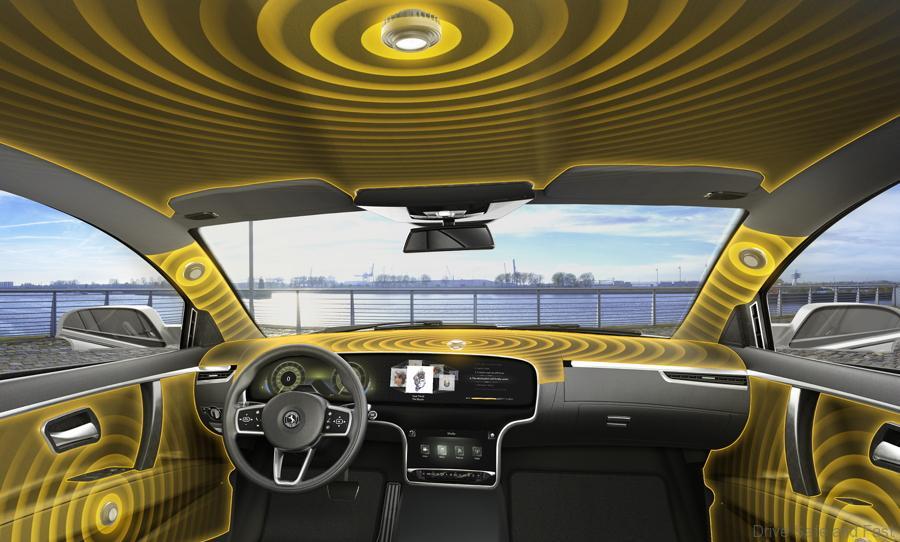Inspired by the functional principle of string instruments, Continental is reinventing the car audio system. The technology company is replacing conventional loudspeakers with actuators that create sound by vibrating certain surfaces in the vehicle. In comparison to conventional speaker technology the speaker-less audio system brings many advantages: At considerably lower weight, with dramatically reduced box volume and lower electricity consumption, the new Continental solution delivers excellent acoustics. Experts such as the renowned Landsberg-based master luthier and graduated physicist Martin Schleske have given the sound system top scores for its performance. By bringing speaker-less sound into vehicles, Continental has taken up a challenge. Irrespective of the vehicle segment, drivers’ expectations towards car audio systems are usually very high. This is the reason why current audio systems typically require many speakers to deliver 3D sound via many channels. From a design point of view it is not easy to integrate these many point sources.
“In the age of electric vehicles, car manufacturers are looking for innovative solutions to drastically reduce the weight of their vehicles and gain space for passengers and new technologies ”, said Johann Hiebl, head of the Continental business unit Infotainment and Connectivity. “On the other hand, design and sound quality may not suffer from this goal. Our approach is to treat the car itself as an instrument. We use compact actuators to excite suitable surfaces to thus generate a natural, 3D sound experience.” The challenge lies in the profound understanding of NVH in the widest sense which is required to achieve excellent acoustics. “Typically experts have either the vehicle expertise or the acoustics expertise. Continental has both in-house plus the manufacturing know-how.”
In direct comparison to a conventional high-end vehicle audio system a speaker-less solution can reduce the system volume by a factor of ten or higher, while bringing down the system weight to a fraction of a speaker solution. The invisible car audio technology can be integrated into any car model from high end sedans to small electric vehicles.
Treating the vehicle as an instrument
The mix of tweeters (high frequency speakers), midrange speakers and subwoofers which together make a conventional high-end car audio system frequently interrupts the original interior surfaces with the typical look of a speaker front. Designers do not always welcome this. “Moreover, it is not necessary to integrate speakers with oscillating membranes when you have all the surfaces you need to do the job in the car already”, said Dimitrios Patsouras, director competence center NVH at Continental Engineering Services. The rationale behind this invisible audio system is to avoid this kind of duplication and utilize existing components for even better results.
The sound waves are generated by compact actuators, which are similar to the core of a conventional speaker. These transducers consist of a magnet and a coil, which generate micro-vibrations. However, instead of an oscillating membrane which is part of a current speaker, larger existing components and surfaces in the vehicle are excited by the transducers to radiate the sound. “If you take a violin for comparison, the bow and strings are the transducer. The violin’s bridge equals the location and bonding of the transducer to the surface which equals the instrument body”, said Patsouras. Specific areas in the vehicle lend themselves to each of the required three main frequency ranges. “The A-pillar is suited for high frequencies, while the door panels, for instance, have the right properties for generating medium frequencies. Similar to speaker technology, we use large components such as the roof lining or rear shelf to generate low frequencies”, Patsouras explained. To achieve a good 3D sound, conventional high-end car audio systems can easily require between ten and 20 or more speakers. Owing to a conventional speaker design this gives the system a weight of up to 15 kilograms and a total box volume of 10 to 30 liters. Continental’s speaker-less audio system can weigh as little as 1 kilogram and requires as little as 1 liter of total box volume. “However, the main benefit is the quality of the sound. Even experts listening with a discerning ear have given us the highest praise for our invisible system’s acoustics”, Patsouras said.
In a demo vehicle, Continental is also presenting the scalability of the system by switching between an entry-level low-cost system using three audio channels, a mid system using four to six channels and even a premium solution using up to 12 channels. Thereby, even the front seats are used as sound bodies to intensify the bass experience and to provide passengers on the rear seats with a totally new audio experience. On top, it is even possible to compare the speaker-less audio solution with a high-end speaker solution of a premium manufacturer.
Speaker-less technology offers further potential beyond car audio: It can also provide a sound source for human-machine interaction concepts, such as navigation instructions or the indicator sound. “Speaker-less technology can also be used for sounds as part of the human-machine interaction concept with the added benefit of generating the sound where the driver’s attention should ideally be. We see great potential for the speaker-less system as a part of functional audio concepts”, Patsouras concluded.





